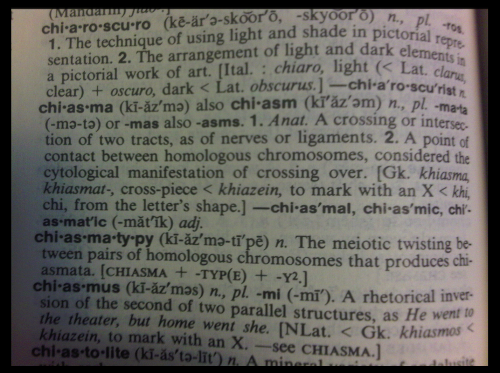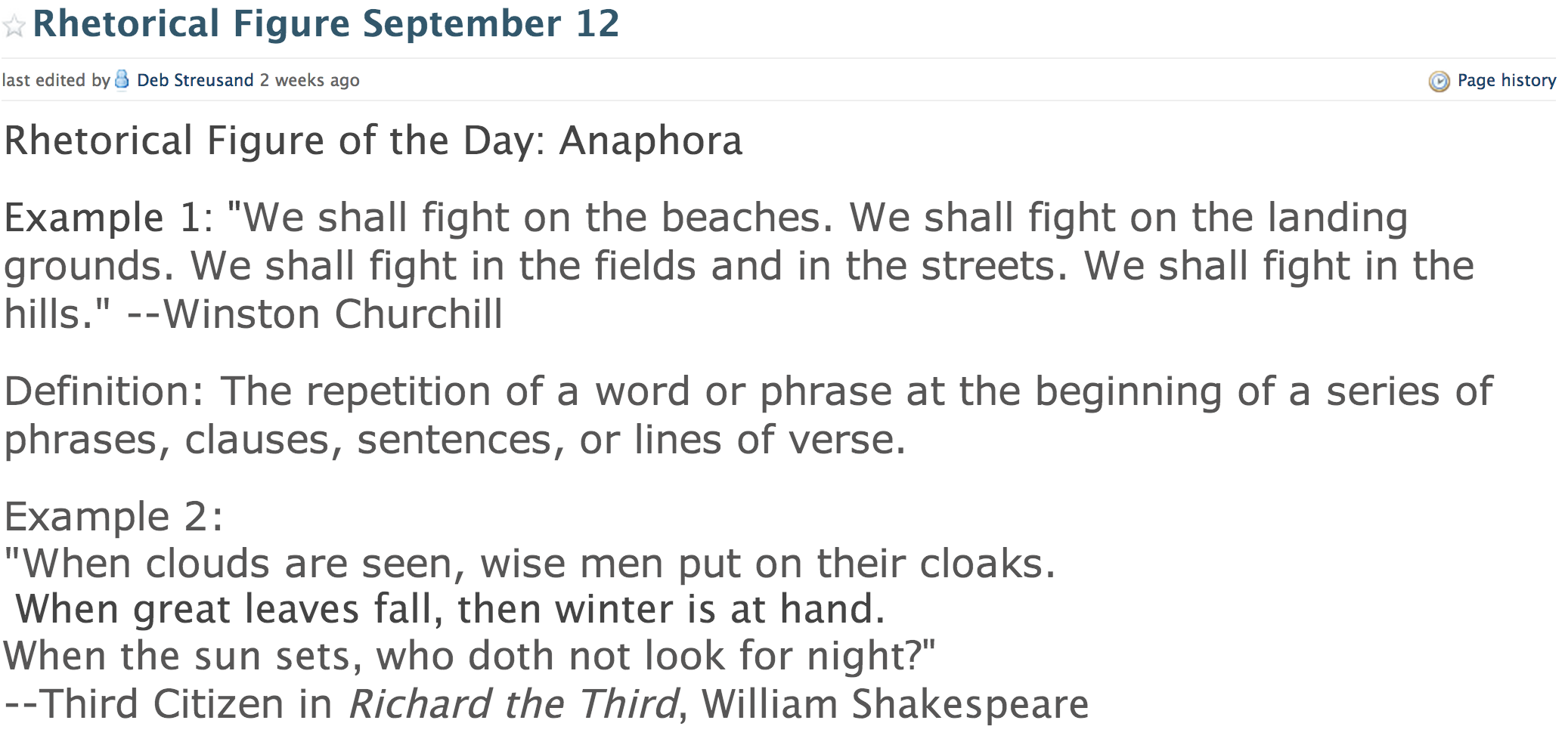
Image Credit:
StaffordGregoire. Original image is here.
As a PhD student new to UT, I came to my teaching at the Department of Rhetoric and Writing with a knowledge of rhetoric derived from my experience at Mary Baldwin College's Shakespeare and Performance program. Professor Ralph Alan Cohen taught MFA students about the classical rhetorical figures Shakespeare would have learned in grammar school. We studied their role in Shakespeare's text and explored how actors can make use of them in performance. I quickly discovered that this type of rhetoric was not on the curriculum for RHE 306, but I thought my students might benefit from some exposure to it all the same.
I decided to turn it into a sort of warm-up, the “rhetorical figure of the day,” before we launched into discussing the rhetoric of modern controversies. (This exercise would come right after my “morning question,” in which I asked the students something about themselves that was also related to RHE 306’s topic of consumer culture, like “what is your favorite possession?” or “what would you do with a million dollars?”)
I told my students upfront that the rhetorical figure of the day wasn’t something they were going to be tested on or that they needed to memorize. I would be teaching them these things because I thought it was important: I believed it would be valuable for them to recognize the use of these tools in a text or, even better, learn how to employ the figures themselves.
From my students’ perspective, this is what the rhetorical figure of the day looks like on the projector:
I uploaded each figure to the class website, so that the students could refer back to it whenever they wanted. At first, I would select one example from a famous speech and one from a literary text, so that the students could get an idea of the different contexts in which these figures appear. I wrote the definitions myself, but also consulted Richard Lanham's A Handlist of Rhetorical Terms and Gideon O. Burton’s Silva Rhetoricae.
For the first two weeks, “rhetorical figure time” went like this:
-Student 1 reads Example 1
-Instructor reads the definition and explains it
-Student 2 reads Example 2
-Instructor attempts to explain what the rhetorical figure is used for and what it does.
Rhetoric is no exact science, however, and so I use “attempts” advisedly. I found it difficult to explain what I thought the rhetorical figures did and how they accomplished it, so I decided to ask the students what they thought instead. After the second student finished reading the above example from Richard III, I asked, “so, what effect do you think the anaphora has here?” I thought I might be faced with silence, but two students jumped in quickly. “It hammers it into your head when they repeat it like that,” said one. And then, oh joy of joys for my nerdy heart: “this is one of my favorites,” said another, “because you start to expect a kind of peak, when they get to the end of the repetition.”
Having the students discuss the effect of the rhetorical figure worked better, but I still felt I could do more to engage those who weren’t speaking up. Chatting with my fellow instructors, I noted the success they’d had getting students’ attention through the use of videos. I started looking around for videos and music that used rhetorical figures. On American Rhetoric, I found some examples from movies I knew my students would be familiar with:
--The Lion King's Scar shows off his zeugma (2:56)
“You are talking to a man who has laughed in the face of death, sneered at doom, and chuckled at catastrophe.”
--The Wizard of Oz is also a wizard at isocolon (3:42)
I showed my students clips from these movies in the place of Example 1, and then led a brief discussion as before. What I found was that when playing a bit from a movie, even a short clip, it’s almost impossible to study a single rhetorical figure in isolation. Scar uses three more rhetorical figures in the two lines surrounding the quote above, and the Wizard has a great bit of rhetoric coming up right after the moment I chose. I tried to pause the clip after the part I was interested in, but if I came in even a few seconds late with the pause button, there was already more rhetoric coming our way. I tried to use these accidents to convey to my students how much rhetoric surrounds us all the time.
Meanwhile, my “morning question” exercise was running out of steam, as I struggled to come up with new questions that both had to do with consumer culture and would allow my students to share something about themselves. So, I decided to change up the morning routine by having one student at a time bring in a favorite piece of rhetoric for each day. I started by giving them the St. Crispian’s Day speech from Shakespeare’s Henry V, reading it to them and telling them what I liked about its rhetoric. I hit a snag with the next class because the student I thought had volunteered wasn’t prepared, but then it turned out that another student had gotten excited and had his all ready to go. He had printed out the “Wear Sunscreen” advice column by Mary Schmich of the Chicago Tribune for us, and he showed us a YouTube video of the song “Everybody’s Free (to Wear Sunscreen),” a Baz Luhrmann remix of the column read aloud and the Rozalla song “Everybody’s Free (to Feel Good).” He didn’t use the exact language of the rhetorical figures, but he did talk about the juxtaposition between the serious and the comic in the text, and how the alternation between long, complex phrases and single verbs of advice heightened that contrast. The class discussed the effect of putting the music underneath the words of the text.
As I was arranging my next volunteer, a student who hadn’t spoken much suddenly cut in: “I think you said this in the first class, but…why this rhetoric stuff? I mean, I’m never going to use this, so why?” In a movie, I would have had a perfect, inspiring speech ready to go. In reality, I said something like this: “well, that’s a valid question, and I can see why you would think you wouldn’t use it. But these rhetorical figures really do help to persuade people when you’re making an argument, whether you’re trying to get funding for something that you care about, or asking your boss for a raise, any time you want to persuade someone. The reason the figures have such weird Greek names is because people have been using them to convince other people for more than two thousand years. So you may not see it right now, and as I said, it’s a very valid question, but you may end up using these, and if you do, you’ll have an advantage.” If I were writing the movie script for that moment, I might make my answer a bit less financially focused and a bit more idealistic, but at the same time, I think choosing those practical examples might have actually made an impact on my skeptical student. We’ll see when she brings in her favorite piece of rhetoric!
This coming week’s rhetorical figure media samples will come from hip-hop songs, thanks to my Mary Baldwin colleague Angelina LaBarre’s MLitt thesis, “Entering the Educational Cypher: Hip-Hop and Shakespeare in the Classroom.” Future weeks will feature standup comedy and advertising. I’m having great fun with the process of expanding my library of rhetorical figure examples, because I’m still finding new places where rhetoric is hiding. I can’t wait to see what my students bring in over the next few weeks.


